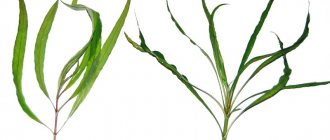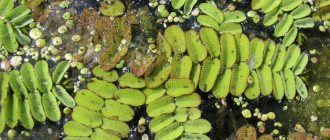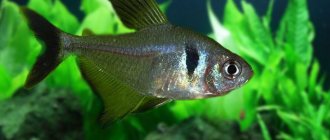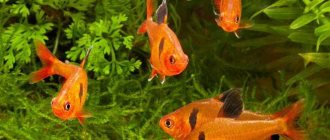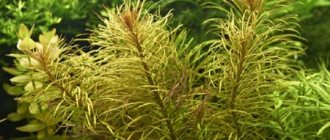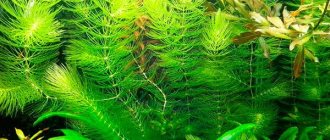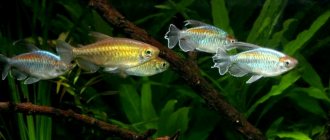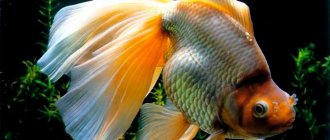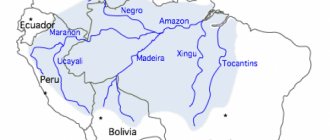Habitat and appearance characteristics
Thailand, or Javan, fern (Microsorum pteropus) is a representative of the order Centipedes. In the wild, it inhabits the coasts and water bodies of Southeast Asian countries (Java, Malaysia, Thailand, northeastern India). There are varieties with different sizes and shapes of leaves: narrow, lanceolate, needle-shaped. The most common is narrow-leaved.
In a tropical environment, an adult plant reaches its largest size - 50-60 cm. The average height of an aquarium specimen is 20-30 cm.
Elongated roots with thread-like branches (rhizoids) cling to parts of trees and stones. The bright green foliage has an elongated lanceolate shape. In a favorable microclimate, plants form dense thickets that stretch to the surface. During long-term growth, small spores appear on the leaves, changing color to a darker one.
The fern grows in water and on land and does not require intense lighting or frequent addition of CO2. Gets along with fish that eat green plants. Decorates any area of the aquarium.
Java moss (Vesicularia sp.)
The third element of the lazy aquarium triad is Java moss (Vesicularia sp.) . Just like the first two plants, moss can be tied in bunches to driftwood and stones, and if you have a lot of moss, then wrap it around the whole snag. Don’t be alarmed that in the first couple of weeks it will look like a piece of sponge - soon this “scrub” will straighten out and turn into a beautiful fluffy bush, very elegant in appearance. If wrapping driftwood with moss seems to you an activity that is risky from the point of view of the aesthetics of your future aquarium, simply collect the moss into neat bunches, tie a small pebble to each bottom with a thread, and place it at the back and side walls, in the corners of the aquarium, and wherever you want. it will seem more interesting. Each such bunch will also quickly turn into a neat bush.
Java moss on stone
Rozhdestvensky moss
Java moss on lava
Java moss on a bioball
Types of Thai fern
There are dozens of varieties of Thai fern in specialized stores. The most popular include 9 varieties.
Narrow-leaved Microsorum pteropus Narrow
The subspecies gained popularity among amateurs not so long ago. The length of the roots reaches 15 cm, and the foliage is 18-20 cm. An unpretentious plant is suitable for decorating small containers; narrow leaves are decorated with intricate driftwood. The price of a copy is 60-80 rubles.
Microsorum pteropus Undulata
The variety has delicate wavy foliage of light green color. The bush reaches 30-35 cm in height and 25 cm in width. Thanks to its wide leaves and volume, it is suitable for aquadesign of large aquariums. The exotic variety is rarely found on sale, so the price of a specimen is higher - 200-250 rubles.
Philippine winged pteropus Philippine
Thailand fern Tropica.
A striking representative of ferns native to the Philippines. Recently it has been in demand among aquarists. Long corrugated leaves grow up to 35-40 cm. The plant is attached to stones by rhizoids or planted in the ground.
A comfortable habitat is salty soft water with a pH level of at least 7 and dim lighting. The growth rate of the specimen is higher than that of other subspecies. Kept in large aquariums. Average price – 175 rubles.
Windelov
A feature of the subspecies is the extraordinary shape of the leaf plate, reminiscent of deer antlers. The length of the leaf cut at the end reaches 12-15 cm, the width of the bush is 20 cm.
Interesting appearance and compactness allow you to create beautiful compositions in small aquariums. Ease of maintenance and low cost (70-120 rubles) make the plant in demand among beginners and amateurs.
Tropica pteropus Tropica
It is considered one of the hardiest varieties. New foliage with smooth edges narrows as it grows, and the plates become jagged. Old leaves fall into pieces, forming a spreading bush 35-45 cm wide. The best option for the background of a large aquarium. The market price is 80-100 rubles.
Fork Leaf Microsorum pteropus Fork Leaf
An ornamental and undemanding fern with a soft green color, it is rarely found in home aquariums. “Horned” leaf blades grow up to 25 cm in length and up to 15-20 cm in width. A dense bush looks interesting anywhere in the aquarium. Contained in water of varying hardness and temperature, does not require bright light and fertilizers. The average cost of a sample is 90-100 rubles.
True narrow-leaved Real Narrow
The variety with the narrowest leaves 2-4 mm wide. The plates are painted marsh color. Does not require special conditions for maintenance. Grown on driftwood and gravel.
Small leaf
The variety with the smallest foliage - up to 7 cm. Green shoots develop in soft or hard water with a pH level of 4-7 and a water temperature of +4...+30°C. Suitable for the front of the vessel.
Red Microsorum Pteropus Red
Young fern leaves are colored red. Over time they lighten, acquiring a light green tint. The bush reaches a height of 30 cm and a width of 20 cm. The leaf blades are wider than those of a simple Microsorum. Wide bushes are suitable for decorating the back wall of a large aquarium. The price of a copy is 150-180 rubles.
Diseases
Thailand fern is an unpretentious plant. He has no diseases as such. Damage can be caused by improper actions taken by the aquarium owner to care for the fern. Therefore, strict adherence to recommendations for the quality of lighting, chemical composition of water and temperature conditions will keep the plant in excellent condition for a long time.
If you find wilted leaves, carefully cut them off using scissors. This action will allow new leaves and roots to grow.
Benefits for the aquarium
Fern is a natural water purifier in a container. In the process of life, it absorbs both useful and harmful substances. It is recommended to plant the plant in the center line, this will cover a larger area for cleaning.
Fish spawn in the leaves, and viviparous species hide in dense thickets during birth. Defenseless males find shelter from predators.
Thai fern is suitable for creating interesting underwater compositions.
Compatibility
The Thai fern for an aquarium is of particular value due to the rigid structure of its leaves, so in a tank with herbivorous fish the plant is a real miracle, capable of surviving and performing its decorative functions. The microsorium is placed in the same reservoir with many fish, for example, swordtails, anubias, angelfish, cichlids and even turtles.
But the Thai fern is incompatible with fish that love to dig the ground, for example, catfish or agamixis. Such a neighborhood will lead to a violation of the integrity of the plant roots, and, accordingly, to the death of the microsorium.
Maintenance and care
Microsorum pteropus does not burden owners with maintenance and care.
For the normal functioning of aquatic ferns, it is recommended:
- avoid overheating by lighting fixtures;
- prevent a sharp drop in temperature in the tank;
- populate the aquarium with compatible fish species;
- monitor water quality;
- Promptly trim wilted and damaged shoots with scissors.
With an acute deficiency of nutrients and insufficient lighting, the plant turns pale and slows down until a suitable microclimate is created.
Aquarium parameters
The growing tank is selected according to the height of the tropical plant. Bright greenery is suitable for decorating a deep and voluminous aquarium.
Thai fern Vindelov.
Since the species prefers a calm atmosphere, it is recommended to grow it away from filtration equipment. Fragile shoots cannot withstand constant mechanical stress.
To provide each specimen with a sufficient amount of micro- and macroelements, it is necessary to maintain a distance when planting - up to 20 cm from each other. Dense bushes grow more slowly because their roots are intertwined, which slows down the development of the entire population.
Water
The plant loves soft, neutral water without sudden temperature fluctuations. A comfortable environment for the growth of most varieties of fern is a tropical climate with a temperature of +25...+30°C. In cool water, the culture slows down its development. A suitable hardness level is 0-6°dH, acidity level (pH) is 4-6. It is recommended to replace 15-20% of the total water volume 1-2 times a month.
Lighting
Most Microsorum varieties prefer dim artificial or natural diffused lighting. The plant slows down its growth during prolonged darkness. The recommended daylight hours are 10-12 hours. It is recommended to use incandescent lamps or fluorescent lamps with dim white light as lighting devices. The power is selected in accordance with the volume of the aquarium at the rate of 0.3-0.5 W per 1 liter.
An excess of illumination causes the foliage to become brown and transparent. When burned, the plates turn yellow and fall off. It is necessary to diffuse sunlight and reduce the intensity of artificial lighting.
Priming
Many varieties of Java fern do not require soil and do not need additional fertilizers (fine-grained silted sand is sufficient). Due to the undeveloped rhizome, which spreads over the substrate, the plant becomes attached to decorative elements, snags or coarse gravel.
The following means are used for fastening:
- glue;
- fishing line;
- thin silk thread;
- tourniquet
After weighting, the bush can easily be moved to any corner of the tank.
Top dressing
Intensive development and growth of representatives of Microsorum pteropus requires regular application of fertilizer (at least 2 times a month). The fern receives all its beneficial substances from water. For enrichment, liquid nitrogen fertilizer urea (urea) is used, which is applied at the rate of 10-12 granules per 100 liters. The supply of CO2 and universal mineral compounds when changing the water in the container has a beneficial effect on the development and saturation of color. Due to the lack of a developed root system, fertilizing in the form of root tablets is not suitable.
Correct fit
The plant grows well on any soil, being attached to a heavy object - a stone, a bulky snag. Its slow growth is an advantage from the aquarist's point of view, since it does not require frequent pruning and removal of excess shoots.
In order to best purify the water, the thickets must be placed in the middle of the vessel. Well, when it comes to design, the owner of the aquarium can fully use his imagination.
When planting a Thai fern, you can use various methods - all of them are successfully used by both amateurs and professional aquarists. To decorate the container, you can use:
- fishing line for attaching bushes;
- nylon thread to tie the rhizome to snags or stones;
- rubber bands (in an aquarium, however, this does not look aesthetically pleasing);
- superglue of the “Moment” type: a few drops should be applied only to the required place, after which the roots at the point of contact will die, but by this moment the plant will have grown and will be able to securely attach to the support.
Important! Ferns do not tolerate frequent interventions and transplants.
Features of breeding Thai fern
Tropical fern propagation occurs vegetatively. From the old bush, daughter bushes with 2-3 leaves are separated. Afterwards they are tied to a wooden strip or pebbles at a short distance from each other for rooting.
The second method of propagation is the formation of young shoots on the leaves of an adult plant. After the mother leaf turns black and dies, the cuttings separate and remain floating on the surface. Once long floating roots have formed, the seedlings are prepared for planting. To create a dense carpet, a mesh is used, to which the roots are tightly tied. Growth rate is 2-3 weeks.
Wing-shaped and narrow-leaved ferns do not tolerate frequent transplants and frequent blowing.
Reproduction
Wing fern reproduces vegetatively. This process is carried out in two ways:
- By separating from the whole bush a small piece with two to three leaves and part of the root. The resulting shoot is carefully transplanted to a new location.
- A new, daughter plant that can form on old leaves. It is necessary to wait for the moment when the new sprout, together with the leaf on which it formed, separates from the main part of the plant and floats to the surface. After a short period of time, the development of the young plant’s own root system becomes noticeable. As a result, it becomes heavier, sinks to the bottom, and the old leaf falls off. At this moment, the task of the aquarium owner is to choose a place and secure a new fern.
Important! Frequent replanting of the plant is unacceptable, since such interventions affect the growth rate and quality of the leaves.
